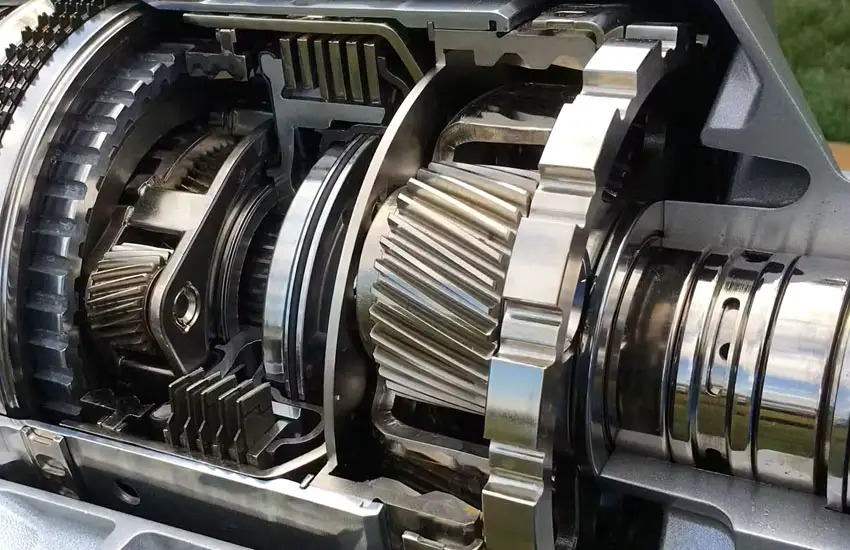As an Amazon Associate, I earn from qualifying purchases at no extra cost to you.
Can You Fix a Slipping Transmission Without Replacing It?
A slipping transmission can be a nightmare for car owners, causing frustration and uncertainty about how to proceed. The feeling that your vehicle is losing power, not shifting gears properly, or even stalling can be alarming. You may wonder, “Can I fix a slipping transmission without having to replace it entirely?”
This is a common question among drivers, especially since transmission repairs can be costly. Fortunately, in some cases, a slipping transmission can be repaired without the need for a full replacement. In this blog post, we will explore the various options available to fix a slipping transmission, and we'll go over whether it's possible to repair or adjust it without replacing the entire transmission system.

What is a Slipping Transmission?
A transmission "slips" when it unexpectedly changes gears or fails to stay in the selected gear. This typically occurs when the transmission cannot engage the selected gear correctly, leading to the engine revving higher or the car feeling like it is not responding to the throttle as it should. This problem can happen in both manual and automatic transmissions but is most commonly associated with automatic transmissions.
When you experience a slipping transmission, you may notice the following symptoms:
- Delayed or hard shifting: Your car might have trouble changing gears or experience a delay between pressing the gas pedal and the car actually moving.
- Unusual RPM spikes: The engine revs up higher than normal, especially when shifting gears, without a corresponding increase in speed.
- Grinding or whining noises: Unusual sounds coming from the transmission area when shifting gears can also indicate slipping.
- Stalling or jerking: Your car might stall unexpectedly or jerk when trying to accelerate or shift gears.
These symptoms signal that your transmission isn't functioning properly. However, the cause of the slipping could range from low transmission fluid to internal damage in the transmission itself.
Can a Slipping Transmission Be Fixed Without Replacing It?
The short answer is: yes, in many cases, you can fix a slipping transmission without replacing it. The key is to determine the root cause of the problem. Some common issues causing transmission slippage are relatively easy to address with maintenance and repairs. However, other problems may require more advanced fixes that could potentially be more expensive.
Let's go through the various possible causes of a slipping transmission and how they can be repaired without a complete replacement.
1. Low Transmission Fluid
One of the most common reasons for a slipping transmission is low transmission fluid. Transmission fluid is essential for lubricating the moving parts inside the transmission, and it also helps to cool the transmission. When the fluid level drops too low, it can cause friction, overheating, and improper gear engagement, which leads to slipping.
Fixing Low Transmission Fluid
Fortunately, this is one of the simplest problems to address. If your transmission is slipping due to low fluid levels, the solution is as easy as topping up or replacing the transmission fluid. Here's how you can fix it:
Check the Fluid Level: Most vehicles have a dipstick specifically for checking transmission fluid, just like engine oil. You can locate this dipstick under the hood. The fluid should be red or pink in color and free of debris.
Add Fluid if Necessary: If the fluid level is low, you can purchase the correct type of transmission fluid for your vehicle and add it. It's important to ensure that you use the right fluid because using the wrong type can worsen the problem.
Replace Fluid if Contaminated: If the fluid is dark brown or has a burnt smell, it's a sign that it's old and no longer providing adequate lubrication. In this case, a full fluid replacement is necessary to restore proper function to your transmission.
After topping up or replacing the fluid, if the transmission continues to slip, there may be an underlying issue that requires professional attention.
2. Worn or Dirty Transmission Filter
The transmission filter is responsible for keeping debris, dirt, and metal particles from contaminating the transmission fluid. If the filter becomes clogged, the fluid can't flow properly, leading to a lack of lubrication and, eventually, slippage.
Fixing a Clogged Transmission Filter
Changing the transmission filter is a relatively straightforward fix. Here's how you can address this issue:
Locate the Filter: Depending on your car model, the transmission filter may be accessible from underneath the vehicle or through the engine compartment. In most cases, you will need to remove the transmission pan to access the filter.
Replace the Filter: Once you have removed the pan, you will be able to see the filter. Remove the old filter and replace it with a new one. Be sure to clean the pan and check for any metal shavings or debris that may indicate internal transmission damage.
Refill with Fresh Fluid: After replacing the filter, you will need to refill the transmission with fresh fluid. Again, make sure you use the correct type of fluid for your vehicle.
This simple maintenance task can sometimes resolve transmission slippage. However, if the filter is clogged, but the transmission still slips after the filter is changed, there could be further damage inside the transmission.
3. Faulty Transmission Bands or Linkages
In automatic transmissions, bands and linkages are responsible for shifting the gears. Over time, these components can wear out, become misaligned, or become damaged, leading to slippage or difficulty engaging gears. Fortunately, this problem may be fixable without replacing the entire transmission.
Fixing Worn Transmission Bands or Linkages
Adjust the Bands: Transmission bands are adjustable on some vehicles. If your car's model allows it, you can adjust the bands to restore proper gear engagement. You will need a mechanic to help with this adjustment if you’re not familiar with the process.
Replace the Linkages: If the issue lies with the linkages, they may need to be replaced entirely. Linkages are typically easy to replace, and this may resolve the slippage problem.
If these components are damaged beyond repair, however, they will need to be replaced, which can be a more involved and expensive procedure.
4. Worn Torque Converter
The torque converter is a critical component of an automatic transmission. It connects the engine to the transmission and is responsible for transmitting power from the engine to the transmission. If the torque converter is damaged or worn out, it can cause slipping in the transmission.
Fixing a Worn Torque Converter
Unfortunately, a worn or damaged torque converter typically cannot be repaired. The only real solution to this problem is to replace the torque converter. However, if you catch the issue early, it may be possible to address the symptoms before the problem worsens.
Check the Fluid: If your torque converter is failing, it's often due to a fluid flow problem. Start by checking the fluid and replacing it if necessary.
Replace the Converter: If the fluid is clean and the issue persists, you may need to replace the torque converter. This can be a complex repair, but it's still less expensive than replacing the entire transmission.
5. Electrical Issues (For Modern Vehicles)
In modern vehicles, many transmissions rely on electronic systems to control gear shifts and fluid pressure. A malfunction in the transmission control module (TCM), sensors, or wiring can cause the transmission to slip or behave erratically.
Fixing Electrical Problems
- Diagnose the Electrical System: You will need to use a diagnostic scanner to read any error codes from the vehicle's onboard computer system. The error codes will point you in the direction of the faulty component.
- Replace Faulty Sensors or Modules: If a sensor or TCM is faulty, replacing it may resolve the issue. This may be a more affordable fix than a full transmission replacement.
6. Overheating Transmission
Excessive heat is one of the leading causes of transmission slippage. Overheating can cause the transmission fluid to break down, leading to poor lubrication and erratic shifting. This is often due to poor cooling, such as a failing radiator, faulty cooling lines, or a clogged transmission cooler.
Fixing an Overheating Transmission
Check the Radiator and Cooling System: Ensure that the radiator and cooling lines are functioning properly. If there is a blockage or leak, fix it immediately.
Install an External Transmission Cooler: If your transmission is consistently overheating, you might want to consider installing an external cooler to help maintain optimal temperature levels.
By addressing cooling issues, you can prevent your transmission from slipping due to overheating and extend the lifespan of the system.
I hope this post has helped you understand the different ways you can fix a slipping transmission without needing to replace it. From checking and topping up transmission fluid to replacing filters or fixing faulty linkages, there are several maintenance tasks and repairs you can attempt before opting for a full transmission replacement. However, if these fixes don't resolve the issue, it's always a good idea to consult a professional mechanic for a deeper diagnosis.
Are These Questions in Your Mind?
Is it safe to drive with a slipping transmission?
Driving with a slipping transmission can be risky. It may cause further damage to the transmission or leave you stranded on the road. It's best to have it repaired as soon as possible.
Can low transmission fluid cause slipping?
Yes, low transmission fluid is one of the most common causes of transmission slippage. It reduces lubrication and can cause the transmission to overheat, leading to slipping.
Do I need to replace the transmission if it's slipping?
Not always. In many cases, transmission slippage can be fixed with a fluid change, filter replacement, or other repairs. However, if the transmission is severely damaged, replacement may be necessary.
Is it possible to repair a transmission without removing it from the car?
In some cases, yes. Repairs like changing the fluid, replacing the filter, or adjusting transmission bands can be done without removing the transmission.
Can overheating cause a transmission to slip?
Yes, overheating can cause a transmission to slip. When the transmission fluid gets too hot, it breaks down and loses its ability to lubricate the transmission, leading to slippage.
Do I need special tools to fix a slipping transmission?
Some repairs, such as replacing the fluid or filter, can be done with basic tools. However, more advanced repairs may require specialized tools and knowledge.
Is it expensive to fix a slipping transmission?
The cost depends on the cause of the slippage. Simple fixes, like adding fluid or replacing a filter, are inexpensive. More complex repairs, such as replacing a torque converter, can be more costly.
Can transmission fluid be checked at home?
Yes, many vehicles allow you to check the transmission fluid level at home using a dipstick. Make sure to refer to your owner's manual for specific instructions.
Do I need to replace my torque converter if it's causing slippage?
If the torque converter is worn or damaged, it will likely need to be replaced. This is a more involved repair but may be cheaper than replacing the entire transmission.
Is it possible to prevent transmission slippage?
Regular maintenance, such as changing the transmission fluid and filter, can help prevent slippage. Additionally, avoiding overheating and keeping the transmission system clean can extend its life.











